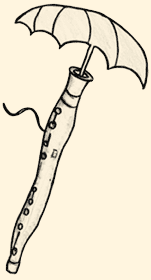 |
|||||||||
 |
About Marvin Roth Biography & Home Recording Project • Resumé Biography
I left the University of Miami in my junior year to enlist in an Airforce Band in 1942. The conductor of this band loved the bassoon and was able to get me a 5000 series Heckel (with US stamped on it). We played the William Tell Overture a billion times in the next 4 years (he wanted the bassoon to play that opening cello solo all the time). Well, I couldn't imagine marching with a bassoon so I grabbed an Alto Sax from the supply room, taught myself how to play it, and that was the beginning of what I ended up doing when a couple of band buddies suggested I head for New York after the war and go for the doubling scene since bassoon was my strong horn. I soon latched on to the clarinet and when I came to the Big Apple after my discharge in 1946, I began Flute lessons. By this time I had 4 years of experience playing Baritone Sax and clarinet in the Airforce Dance Band. 
So, in 1947 I end up playing bassoon, Tenor Sax, and Clarinet in the Boyd Raeburn big band and had played with him for a year when I landed my first Broadway show. I was now a "certified doubler". I went on to play 24 shows in 42 years — the last one, "A Chorus Line", ran for 15 years. When it closed in 1990, I kissed the Broadway scene goodbye (I was 69). During all those years I managed to squeeze in 3 seasons of Opera & Ballet in Canada, played lots of jingles, did some subbing up at ABC radio & TV, played 10 years with a Young Audiences Woodwind Quintet, and this is my 25th year with a music & arts organization going into elementary school classrooms reading stories and talking about music and musical instruments. I'm in a different school 3 mornings a week, with a drummer and a guitar player. I bring an Alto Sax, clarinet, and piccolo. There was a time when I brought the bassoon until the kids began picking at it and bassoon reeds were sacrificed. The people I work for tell me doing these programs is keeping me alive. They may be right! And of course the 2 books of Duets were written and published in 1972-73. I also recently published "30 Melodic Studies for Bassoon." top of page The Home Recording Project
1979–The Flute 1 1/2 hrs. The flute orchestral repertoire. The solos, many of which are standard audition requirements, played by the principal flutists of major orchestras. The same solo will be heard by the players in different orchestras. 1982–Alto Saxophone 2 hrs. A brief, slightly humorous history of the saxophone, the classical composers who were intrigued by this new instrument & wrote orchestral solos for them and how the saxophone found its way into the jazz scene. 1983–A Chronological History of Jazz from 1885-1980's 12 1/2 hrs. How & where jazz was born, following its movement from the southern states & spreading in all directions. All documented on recordings by the musicians who made it happen. 1984–The Bassoon 1 1/2 hrs. A tribute to my first bassoon teacher, Bob Reinert. A tongue in cheek "how to build your own bassoon", and commenting on the many moods a bassoon can convey via listening to orchestral repertoire solos.–ending with 2 of my Bassoon Duets. 1985–The Trombone 7 1/2 hrs. This one is laced with humor while taking it through its invention, some classical solos & eventually finding its way into jazz, including brief bios of the famous jazz trombonists & listening to them do their thing. 1987–The Clarinet 9 hrs. A history of the clarinet, its evolution, its famous players in classical music, heard on numerous examples in the clarinet repertoire. 1989–The Trumpet 17 hrs. A history of the trumpet (with a bit of humor) from biblical times–to the cornet/trumpet players in the concert bands, & through the period when trumpet players used strange instruments in the baroque period–& finally, when valves were built into the instrument, & those players who at long last realized this was the perfect horn to play jazz on.-featuring trumpet players born from 1867-1944.  1994–The Drums/Percussion Project
1994–The Drums/Percussion Project6 1/2 hrs. Featuring 37 drummers born from 1898-1930.-A mega assortment of the bands big & small. The question? Where would jazz be without the guy (or gal) sittin' behind that drum set? Listen & find out! 1999–Big Band Vocalists, Pop Singers, & Singing Groups 6 1/2 hrs. Contains just what the title implies. It includes brief bios of most of the singers. top of page |
||||||||
 |
This website copyright 2011 Marvin Roth Site Design: Canfield Design Studios, Inc. |
||||||||



